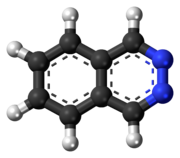Phthalazine

| |

| |
| Names | |
|---|---|
| Preferred IUPAC name
Phthalazine[2] | |
| Other names
Benzo-orthodiazine
2,3-Benzodiazine Benzo[d]pyridazine | |
| Identifiers | |
3D model (JSmol)
|
|
| ChemSpider | |
| ECHA InfoCard | 100.005.422 |
PubChemCID
|
|
| UNII | |
CompTox Dashboard(EPA)
|
|
| |
| |
| Properties | |
| C8H6N2 | |
| Molar mass | 130.150g·mol−1 |
| Appearance | Pale yellow needles |
| Melting point | 90 to 91 °C (194 to 196 °F; 363 to 364 K) |
| Boiling point | 315 to 317 °C (599 to 603 °F; 588 to 590 K) (decomposition) |
| Miscible | |
| Acidity(pKa) | 3.39[3] |
Except where otherwise noted, data are given for materials in theirstandard state(at 25 °C [77 °F], 100 kPa).
| |
Phthalazine,also called benzo-orthodiazine or benzopyridazine, is aheterocyclicorganic compoundwith the molecular formula C8H6N2.It isisomericwith othernaphthyridinesincludingquinoxaline,cinnolineandquinazoline.
Synthesis
[edit]Phthalazine can be obtained by thecondensationof w-tetrabromorthoxylene withhydrazine,or by thereductionof chlorphthalazine withphosphorusandhydroiodic acid.[4]
Properties
[edit]It possessesbasicproperties and forms addition products withalkyl iodides.[4]
Reactions
[edit]Upon oxidation withalkalinepotassium permanganateit yieldspyridazine dicarboxylic acid.Zincandhydrochloric aciddecompose it with formation of orthoxylylene diamine. The keto-hydro derivativephthalazone(C8H6ON2), is obtained by condensing hydrazine with orthophthalaldehydoacid[citation needed].On treatment withphosphorus oxychloride,it yields a chlorphthalazine, which withzincandhydrochloric acidgives isoindole (C8H7N), and withtinand hydrochloric acid, phthalimidine (C8H7ON), the secondnitrogenatombeing eliminated asammonia.[4]
References
[edit]- ^Merck Index,11th Edition,7344.
- ^Nomenclature of Organic Chemistry: IUPAC Recommendations and Preferred Names 2013 (Blue Book).Cambridge:The Royal Society of Chemistry.2014. p. 212.doi:10.1039/9781849733069-FP001.ISBN978-0-85404-182-4.
- ^Brown, H.C., et al., in Baude, E.A. and Nachod, F.C.,Determination of Organic Structures by Physical Methods,Academic Press, New York, 1955.
- ^abcOne or more of the preceding sentences incorporates text from a publication now in thepublic domain:Chisholm, Hugh,ed. (1911). "Phthalazines".Encyclopædia Britannica.Vol. 21 (11th ed.). Cambridge University Press. p. 545.
